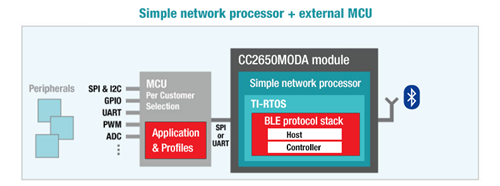SSZTAR3 october 2016 CC2640 , CC2650 , CC2650MODA
Connecting a product to a smartphone via Bluetooth® 4.2 presents two distinct benefits which many applications can leverage:
- A rich user interface (most electronic products outside of phones don’t have a large, hi-res touchscreen)
- Low-power proximity detection and inherent cloud connectivity (a smartphone usually has an internet connection)
With TI’s new SimpleLink™ Bluetooth low energy CC2650MODA module, enabling these advantages for your product is easier than ever.
The pre-certified CC2650MODA module (see the data sheet for the full list of pre-certifications) contains a SimpleLink CC2650 wireless microcontroller (MCU) equipped with 15 general purpose IO (GPIO) pins and an integrated antenna. Using different firmware configurations from the TI BLE-Stack 2.2 software development kit (SDK), this new module from TI can function as either a standalone system-on-chip (SoC) controlling everything in the system, or as a wireless network processor that lets you add Bluetooth low energy connectivity to any existing MCU. In the wireless network processor configuration:
- The Host and Controller components of the Bluetooth low energy protocol stack run on the CC2650 module device, which is pin and code compatible with the SimpleLink Bluetooth low energy CC2640 wireless MCU.
- The application and related Bluetooth services and profiles run on the host MCU, such as the MSP432™ MCU.
Regardless of using the module in a standalone or network processor mode of operation, you will benefit from the 6-10dB better link budget, micro amp standby currents, and improved RF transmission range of the CC2650MODA module.

TI created the simple network processor (SNP) firmware configuration to allow system designers the ability to quickly write a service-level Bluetooth low energy application on the host MCU that focuses on the data exchange with a smartphone. This is accomplished by incorporating a lightweight API library on the host MCU that uses a UART interface to the module. The Bluetooth low energy functions, such as managing a connection with the smart phone, are taken care of by the SNP firmware on the module with the user data exchanged with the host processor.
There are several distinct benefits for using the CC2650MODA module while running the simple network processor configuration with an existing application MCU:
- System partitioning: Have the CC2650MODA module take care of all Bluetooth low energy related activity, while the host MCU can focus on running the system application.
- Easier learning curve: Only use time to learn TI’s simple network processor API, and don’t spend time configuring and compiling the complete BLE protocol stack.
- Field firmware upgrades: The simple network processor can enable secure updating of the host MCU firmware from a smartphone. Now you can maximize revenue by getting your product to market sooner and introduce features and enhancements at a later time.
- Reduced development and manufacturing costs: The module is pre-tested and uses an optimized antenna layout thus reducing the need for expensive board redesigns and performing time-consuming RF tests with expensive test equipment on the production line.
Getting started using the SNP-based design is easier than you may think. Begin by using the CC2650MODA module BoosterPack™ plug-in module and the MSP432 MCU LaunchPad™ development kit. The MSP432 LaunchPad kit is great as a wireless host because it’s a highly integrated 32-bit MCU with a 48 MHz ARM® Cortex®-M4F and 64 kB of RAM.
Your first “hello world” example, called “Project Zero,” can be found here on the TI Resource Explorer. The idea is to create the simplest possible application and show the data path from the smartphone to the host MCU, a MSP432 LaunchPad kit in this case, with data passing over a Bluetooth low energy connection between the smartphone and the BLE network processor on CC2650MODA module. The “Project Zero” application shows how to set/clear LEDs and read button status on the MSP432 MCU LaunchPad kit from a smartphone app. The simplest possible custom Bluetooth low energy profile is created for this purpose but can be extended to read sensor values or send instructions to control a small motor attached to the application MCU, for example.

For your own application development, use Project Zero as a starting point to transform a non-connected device to a fully Internet of Things (IoT) equipped product using the CC2650MODA module. Download and install the TI RTOS for MSP432 MCUs and the connectivity library, then simply use the on-board debugger on the MSP432 LaunchPad and TI’s CCS Cloud development suite to start your Bluetooth low energy peripheral application. A full guide can be found on the SimpleLink Academy introduction to TI’s Bluetooth low energy simple network processor training module.
Want an even broader introduction to TI Bluetooth low energy, including an introduction to why an RTOS is needed for today’s advanced connected applications?
Professor Jonathan Valvano of University of Texas at Austin has just created an online computer science course which covers both TI RTOS and Bluetooth communications. The development platform for this course is the MSP432 LaunchPad kit + CC2650MODA BoosterPack kit! Check out the course here, it’s free if you don’t opt for a verified certificate.